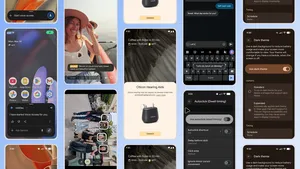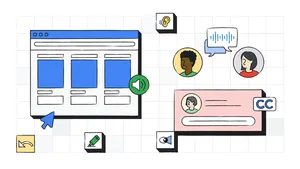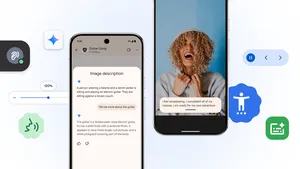From design to development, user feedback shapes Google’s approach to accessibility
It’s a hot day in Jakarta, Indonesia, and the Google Accessibility User Experience team is being shown around the city. Their goal for the next 10 days is to understand the daily experience of various people living with disabilities in this city of more than 10 million people. Notebooks are out, cameras are rolling and Rachmad (a pseudonym), a student who is blind, is eager to share some of his experiences with the team to help us build products that help solve everyday obstacles for him and others.
As the group approaches a bus stop, Rachmad begins asking for help from passersby. A Jakarta local tells him which bus stop he’s at and where it will take him. He turns to the Google Accessibility team and says “Yeah, I kind of have to trust them and hope they are telling the truth.”
After a short bus ride and a long walk, the team returns to Rachmad’s home, where he shows them the four mobile devices he owns, each running different versions of operating systems depending on the task. A researcher notices he’s active within multiple online accessibility support communities and asks him about it. “Sometimes it can be difficult finding help for assistive tools. We try and help each other any way we can,” says Rachmad.
This is a user research field study and it’s demonstrating one of Google’s key values: Focus on the user and all else will follow. User research is core to success throughout a product’s life cycle, and fundamental to creating a product that works for as many people as possible, including people with disabilities. From defining product vision to development and onwards, here's how the Google Accessibility team uses research to ensure our products are more inclusive:
The Google Accessibility team's research study in Jakarta was aimed at understanding the experience of people living with disabilities there

Define the product vision
No matter what the product or service is, it’s important to first understand what problems need solving and how the current solutions could be improved. Observing and talking to a diverse set of users with and without disabilities about their challenges, needs, and workarounds can provide richer insights and drive designs that all users may benefit from. Identifying these insights during early brainstorms and design sprints can help approach problems from different perspectives and lead to more creative solutions.Design with accessibility in mind
The insights gained from observing users can influence all aspects of design including interaction, visual, motion, and writing. Google’s Material Design Accessibility Guidelines and Designing for Global Accessibility principles summarize fundamental principles that help create more accessible products. For example, ensuring there is good contrast between text and the background will help people with low vision or people trying to read a phone screen in the sun. Tools like the Material Color Tool can help make choosing more accessible color palettes easier.Google’s Material Design Accessibility Guidelines provide guidance on accessible design, such as ensuring enough contrast between text and background

Our team often says that "accessible design is just good design." Indeed, if you look at the bigger picture, the goal of creating products is to help people create things, find things, watch things—in short, to accomplish things. Why would any product team want to make it more challenging for a user to accomplish their goals? That's why we encourage teams to use the accessibility design guidelines to influence early design choices. Like most things worth doing, designing with accessibility in mind takes practice and work. But it's key to designing a robust user experience for all.
Develop and iterate
Throughout the design and development of a product, there are many opportunities to get additional input from diverse users. Any type of evaluative research, like usability studies, can be made more inclusive by testing with people with and without disabilities. At this stage, teams can gain more specific insights on the actual experience for the user. For example, an application could present a notification for a longer period so that it doesn’t disappear too quickly for someone with a learning disability or someone who was simply too distracted to read it. While design guidelines can help a product with fundamental accessibility, nothing substitutes for actually watching a person using a screen reader, switch access device, or other assistive technology to truly understand the quality of the user experience.After a product launches
Once a product launches, teams can use feedback surveys, app ratings, customer support calls and emails to get a wealth of qualitative input. And filtering this feedback by users with accessibility needs can continue to paint the picture of their full experience.This is also the perfect time to stop and understand what benefits were gained from designing inclusively from the beginning, and to apply lessons learned to the next product development cycle. Over time, it can become second nature to design inclusively.
Products are a product of user feedback
Returning to our researchers in Jakarta: After they came back from their trip, they worked to bring awareness to their findings by sharing insights and solutions with other teams at Google, including the Next Billion Users group to help them think about accessibility for people in emerging markets. Rachmad’s comments about how it can be difficult finding help for assistive tools informed the creation of a new Google support team dedicated to helping people with disabilities who have questions on assistive technology or accessibility within Google's products. On a product level, the Jakarta team provided valuable input for the group behind Lookout, an app coming soon to the U.S. that helps people who are blind and visually impaired learn about their surroundings. Once available, people like Rachmad will hear cues from their Android phones, helping them gain more independence.Focusing on accessibility from the beginning can influence product direction as well as develop robust insights that teams can learn from and build upon in future work—all in an effort to effectively build for everyone. If you’re interested in helping shape the future of accessibility at Google, sign up to participate in future user studies.





